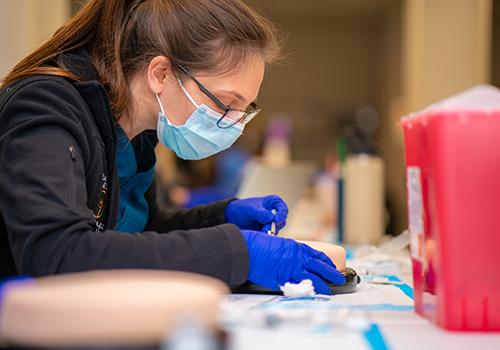
Students admitted to the nursing program are expected to be able to complete all curriculum requirements, 包括身体上的, 认知, 感觉, and behavioral core competencies that are essential to the functions of the entry-level professional nurse.
These core competencies are considered to be the minimum and essential skills necessary to protect the public. These abilities are encountered in unique combinations in the provision of safe and effective nursing care and can meet the criteria with or without reasonable accommodations.
Students who are unsure if they can meet these criteria because of disability, or know they will need help in meeting them, 必须联系St. 博纳旺蒂尔的
无障碍服务办公室 & 住宿 to discuss the use of reasonable accommodations. Reasonable accommodations will be provided that do not substantially alter the requirements or nature of the program.
Applicants must meet the following technical standards:
认知的标准
- recall, collect, analyze, synthesize, and integrate information from a variety of sources
- measure, calculate, reason, analyze, and synthesize data
- problem solve and think critically in order to apply knowledge and skill
- 口头沟通, 通过阅读和写作, with individuals from a variety of social, 情感, 文化, 知识背景
- 口头传递信息, 写, 以及有效的电子表格, 准确地, reliably and intelligibly to individuals and groups, 使用英语
Examples of learning activities found in the nursing curriculum and related to industry standards:
- process information thoroughly and quickly to prioritize and implement nursing care
- sequence or cluster data to determine client needs
- develop and implement a nursing plan of care for clients in acute, long-term, and community settings
- discriminate fine/subtle differences in medical word terminology
- report verbally and in writing client data to members of the health care team
- read and comprehend medical orders and client information found in the medical record
- perform math computations for medication dosage calculations both with and without a calculator
物理标准
- move efficiently enough to meet the needs of patients in a timely fashion
- coordinate fine and gross motor movements
- 协调手/眼运动
- 从任何位置保持平衡
- negotiate level surfaces, ramps, and stairs
- function with both hands free for performing psychomotor tasks
- 小范围机动
- attend to 认知 and psychomotor tasks for up to 7-12 hours
Examples of learning activities found in the nursing curriculum and related to industry standards:
- transfer patients/clients in and out of bed from stretchers and wheelchairs
- 病人翻身和体位
- control a fall by slowly lowering client to the floor
- perform cardiopulmonary resuscitation (CPR)
- lift or move (turn, position) clients or objects; pull or push objects, weighing up to 50 pounds
- reach to shoulder or higher level to place or access equipment such as intravenous fluid bags; bend or squat to access equipment below bed level
- carry equipment and supplies to the client bedside
- manipulate small equipment and containers, 比如注射器, 瓶, 安瓶, and medication packages to administer medications without extraneous movement, 污染, 或破坏
- 准确地 place and maintain position of stethoscope for detecting sounds of bodily functions
- record data with a pen or graphics and other flow sheets
- 操作电脑
- dispose of needles in sharps container
- complete assigned periods of clinical practice (8-12 hour shifts, days, evenings, or nights)
感官标准
- acquire information from 示威活动 and experiences, including but not limited to information conveyed through online coursework, 讲座, 小组活动, 示威活动, 以及应用经验
- collect information through observation, listening, touching, and smelling
- use and interpret information from diagnostic maneuvers
Examples of learning activities found in the nursing curriculum and related to industry standards:
- detect changes in skin color or condition. (苍白、灰白色、灰色或蓝色)
- detect a fire in the client care environment
- draw up a prescribed quantity of medication into a syringe
- observe clients in a room from a distance of 20 feet away
- detect sounds related to bodily functions using a stethoscope
- detect audible alarms generated by mechanical systems such as those that monitor bodily functions, 火警, 敲响钟声
- observe and collect data from recording equipment and measurement devices used in client care
- communicate with client and members of the health care team in person and over the phone in a variety of settings including isolation and the operating room where health team members are wearing masks and there is background noise
- detect foul odors of bodily fluids or spoiled foods
- 探测燃烧材料产生的烟雾
- 检测皮肤温度的变化
- detect unsafe temperature levels in heat-producing devices used in client care
- 发现解剖异常, 如皮下癣, 水肿, 或者是静脉输液
- feel vibrations such as an arterial pulse
行为标准
- demonstrate 情感 stability to function effectively under stress and adapt to changing environments
- maintain effective, mature, and sensitive relationships with others
- examine and modify one’s own behavior when it interferes with others or the learning environment
- possess attributes that include compassion, 同理心, 利他主义, 完整性, 诚实, 责任, 和宽容
- establish a therapeutic relationship and communicate in a supportive manner